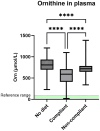Novel Insights Into Gyrate Atrophy of the Choroid and Retina (GACR): A Cohort Study
- PMID: 39761806
- PMCID: PMC11703598
- DOI: 10.1002/jimd.12842
Novel Insights Into Gyrate Atrophy of the Choroid and Retina (GACR): A Cohort Study
Abstract
Gyrate atrophy of the choroid and retina (GACR, OMIM #258870) is a rare inherited metabolic disorder characterized by progressive chorioretinal degeneration and hyperornithinemia. Current therapeutic modalities potentially slow disease progression but are not successful in preventing blindness. To allow for trial development, increased knowledge of the clinical phenotype and current therapeutic outcomes is required. In this study, we analyzed 27 patients with GACR. The median age at inclusion was 24 years (range 8-58), with a median age at diagnosis of 14 years (range 0-42). Symptoms began at a mean age of 9 years (range 0-21). Mixed-models analysis showed a significant association between dietary natural protein intake and plasma ornithine levels. Ornithine increased significantly with age, independent of dietary natural protein intake. We found no statistically significant association between ornithine levels and best-corrected visual acuity over time. Patients who started a natural protein-restricted diet below 10 years of age had better VF outcomes compared to patients that started at a later age. MR spectroscopy was used to asses cerebral creatine deficiency, which was present in 15/20 patients, of whom 10 were supplemented with creatine at the time. Finally, using the Michigan Retinal Degeneration Questionnaire, we provided a first insight into the vision-related disability reported by patients with GACR and showed that higher foveal sensitivity was associated with less perceived disability. To conclude, this study provides insights into the phenotype, genotype, biochemistry, and treatment effects of GACR, which can be used for care pathways and clinical trial design.
© 2025 The Author(s). Journal of Inherited Metabolic Disease published by John Wiley & Sons Ltd on behalf of SSIEM.
Conflict of interest statement
The authors declare no conflicts of interest.
Figures



References
-
- Balfoort B. M., Buijs M. J. N., ten Asbroek A. L. M. A., et al., “A Review of Treatment Modalities in Gyrate Atrophy of the Choroid and Retina (GACR),” Molecular Genetics and Metabolism 134 (2021): 96–116. - PubMed
-
- Montioli R., Bellezza I., Desbats M. A., Borri Voltattorni C., Salviati L., and Cellini B., “Deficit of Human Ornithine Aminotransferase in Gyrate Atrophy: Molecular, Cellular, and Clinical Aspects,” Biochimica et Biophysica Acta (BBA)‐Proteins and Proteomics 1869 (2021): 140555. - PubMed
-
- Valle D. and Simell O., “The Hyperornithinemias,” in The Online Metabolic and Molecular Bases of Inherited Disease, eds. Valle D. L., Antonarakis S., Ballabio A., Beaudet A. L., and Mitchell G. A. (New York, NY: McGraw‐Hill Education, 2019).
Publication types
MeSH terms
Substances
Grants and funding
LinkOut - more resources
Full Text Sources

